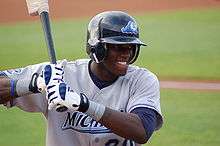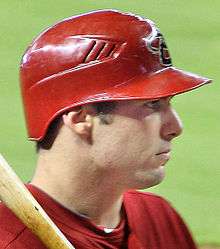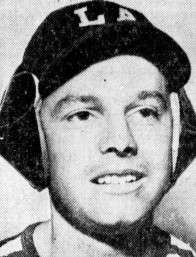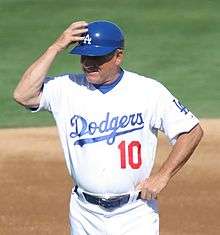Batting helmet
A batting helmet is worn by batters in the game of baseball or softball. It is meant to protect the batter's head from errant pitches thrown by the pitcher. A batter who is "hit by pitch," due to an inadvertent wild pitch or a pitcher's purposeful attempt to hit him, may be seriously, even fatally, injured.


Early concepts (1905–1920s)
In 1905, Mogridge[1] created the first crude protective head gear and was granted patent No. 780899 for a "head protector." This first attempt at a batting helmet was said to look like an "inflatable boxing glove that wrapped around the hitters head."[2] Roger Bresnahan, Hall of Fame catcher who was injured after being struck in the head with a pitch, developed a leather-batting helmet in 1908 which he began using.[1] The helmets were not so much helmets as they were protective earmuffs. They did not protect the actual head of the batter but rather protected the ear and temple region.
In 1908, Chicago White Sox shortstop Freddy Parent wore a head protector of some sort and Chicago Cubs' first baseman-manager Frank Chance did the same thing in 1913, though Chance’s headgear was "little more than a sponge wrapped in a bandage."[2] In 1914, minor leaguer Joe Bosk, playing for the Utica Utes, wore a protector after being severely injured when he was struck in the head by a pitch in 1911.[3]
The first known case of a manager issuing head protectors to his players on a large scale was Philadelphia Phillies' manager Pat Moran who gave cork-cushioned hats to his players in 1921.[2]
Revived interest (1930s–1950s)
Despite the fatal beaning of Ray Chapman in 1920, protective headgear was still used only rarely in the major leagues. After Mickey Cochrane, a Hall of Fame catcher for the Detroit Tigers, suffered a career-ending and near-fatal skull fracture on May 25, 1937 on a pitch by New York Yankees' pitcher Bump Hadley, there was a strong call for batter helmets.[4] Cochrane himself went on record saying that players should "absolutely" be required to wear protective helmets.[2]
Only one week after Cochrane's injury, on June 1, 1937, the Cleveland Indians and Philadelphia Athletics became the first teams to test helmets, using leather and polo helmets respectively. Managers of both teams decided to use batting practice as a test run for helmet use on their players, before a game between the two teams. Though there is picture evidence[4] of the polo helmets being worn in batting practice, there is no evidence of their being used or worn in a game. The first documented team to wear helmets in a game was the Des Moines Demons of the Western League.[2] They also used polo helmets but the idea did not stick, as they only wore the helmets for one game.
The first professional baseball league to fully adopt the baseball helmet was the International League, which did so in 1939 when the list of official equipment used began to include a "safety cap or helmet". Buster Mills was the first player in the league to use a helmet.[2]

The idea of making helmets a required part of Major League Baseball was discussed by officials of the National League in a meeting at the 1940 MLB All-Star Game in Chicago. Ford Frick, president of the National League, showed the helmet he designed with the hopes that the league would adopt it. Though the National League at this meeting did not adopt it, Jackie Hayes became the first player to wear the helmet in a game on August 22, 1940.[2]
In 1941, the National League adopted the use of a helmet, designed by George Bennett, a Johns Hopkins University brain surgeon, for use by all teams in spring training. On March 8, 1941 the Brooklyn Dodgers announced that the team’s players would be wearing the helmets during regular season games. On April 26, 1941 the Washington Senators joined the Dodgers as the only two teams to fully adopt the batting helmet for regular season use. The New York Giants on June 6 and the Chicago Cubs on June 24 also joined the list of teams to fully adopt the use of protective helmets during games.[2]
Though many thought this would be the time when support would be strong enough to develop widespread usage, again tradition won out, and it was not until 1953 that the Pittsburgh Pirates mandated their players wear helmets.[2] The helmet required by Pittsburgh General Manager Branch Rickey (formerly the Dodgers General Manager and President) was created by Charlie Muse and was based on the hard hats used by miners. Soon after, the Ottawa Citizen wrote that "Major League clubs are becoming quite interested in a new type of plastic protective cap which has been put on the market recently." This became even more prevalent when on August 1, 1954, Joe Adcock, a first baseman for the Milwaukee Braves, was struck with a pitch on his head. He was wearing a helmet and, though he was taken off the field on a stretcher, he was uninjured as his helmet took the brunt of the impact and was visibly dented.[2]
In the early 1950s, the governing body of Little League Baseball mandated the use of protective headgear during games for all players. In 1956 the National League followed suit and required the use of batting helmets by all players on all teams. After Little League Baseball announced a better helmet for the use of all players, the American League passed the rule, on March 1, 1958 which required all players to wear helmets.[2] However, though unlike in the NHL in the same era, helmets were widely accepted, it was not until December 1970[5] that Major League Baseball enforced strictly mandatory use of the batting helmet for all batters. Veteran players, however, were given the option of choosing to wear a helmet or not, as they were grandfathered into the rule. The last Major League player who did not wear a helmet while batting was Bob Montgomery, who last played for the Boston Red Sox in 1979[1] Incidentally, the same year the NHL finally made helmets compulsory with a similar grandfather clause for veteran players.
Modifications (1960–2000)

In 1960, Jim Lemon became the first player to wear the new Little League helmet in a Major League game. These helmets were made with earflaps on both sides and were capable of withstanding a ball traveling at up to 120 miles per hour (190 km/h). One month later, Jimmy Piersall became the second player to wear the helmet in the Major Leagues.
With the helmet being worn league wide in Major League Baseball, alterations began in 1961.
On July 23, 1961, catcher Earl Battey was hit in the face with a pitch, fracturing a bone, and 10 days later returned to the field with a makeshift earflap to protect the injured area, though he only wore it for one game because he complained of difficulty seeing while wearing it.[2] Tony Oliva also wore a makeshift face protector during batting practice, as did the Twins’ Jimmie Hall in the 1965 World Series.[6]
In 1964, the Phillies' Tony González was the first to wear a batting helmet with a pre-molded earflap. Prior to this, earflaps had been improvised. González was in the league top-ten in hit by pitches and the special helmet was constructed for his use.[7] Shortly after this, Major League Baseball adopted the use of a helmet with a pre-molded earflap.[6]
Ron Santo was also an early pioneer of wearing earflap helmets at the major league level, upon returning to action after having his left cheekbone fractured by a pitch in 1966. Although helmets with earflaps were common at the amateur levels in baseball, they were slow to gain popularity at the professional level. Some batters felt that seeing the earflap out of the corner of an eye was distracting. Tony Conigliaro was wearing a helmet without an earflap when he was seriously injured by a pitch in August 1967.
In 1978, the next significant helmet remodeling took place when the Pirates Dave Parker wore a hockey mask at the plate after he broke his cheek and jaw bones in a collision at home plate.[8] This lasted only one game and Parker then tried to use a helmet with an attached two-bar football facemask.[8] He also tried a helmet with another football facemask, the Dungard 210 facemask, screwed into his helmet. Other notable players to utilize a modified batting helmet include Gary Roenicke (1979), Ellis Valentine (1980), Terry Steinbach, Charlie Hayes, David Justice, Kevin Seitzer, Terrence Long, and minor leaguer Tony Roth.[8]
In 1983, it was made mandatory for new players to use a helmet with at least one earflap.[9] Players who were grandfathered in could choose to wear a helmet without ear flaps, if they so desired. Players can choose to wear double earflap helmets in the major leagues; however, this is not mandatory. Tim Raines was the last player to wear a helmet without earflaps, during the 2002 season. His flap-less Florida Marlins helmet is currently at the Baseball Hall of Fame. Gary Gaetti, who retired in the year 2000, plus Ozzie Smith and Tim Wallach, who both retired in 1996, also wore flapless helmets until they retired.[10] Julio Franco, who retired from baseball in May 2008, was the last active player eligible to wear a helmet without flaps, but he chose to wear a helmet with an earflap throughout his career. Some players, mostly switch hitters, also decide to wear double earflap helmets while batting. Two players to do this were Orlando Hudson and Chuck Knoblauch.[11]
On April 8, 2004, celebrated as "Hank Aaron Day" in Atlanta because it is the 30th anniversary of Hank Aaron’s record-breaking 715th home run, Braves shortstop Rafael Furcal came to the plate in the sixth inning with a helmet without an earflap, as a tribute to Hank Aaron, who played his entire career in the 1950s, 1960s, and 1970s, and therefore did not wear a helmet with an earflap during his playing career. Umpire Bill Welke made him get one with a flap.
Currently, all leagues up to and including Minor League Baseball require the use of a double earflap batting helmet. In Major League Baseball, however, only one earflap is required (for the ear closest to the pitcher).
Recent developments (Since 2000)

In 2005, Major League Baseball tested a new batting helmet for the first time in nearly three decades. At the All-Star Game in Detroit, players were seen wearing a new "molded crown" helmet that featured side vents, back vents and larger ear holes.[12] The majority of players now wear these new helmets but some including Ryan Howard stayed with the older style.
The no-flap helmet is still utilized in baseball. Catchers often wear a flapless helmet along with a facemask to protect the head when receiving pitches. Occasionally, players other than catchers will wear a batting helmet without earflaps while playing a defensive position in the field. This is usually done by a player who has a higher-than-normal risk of head injury. One example is former major-league player John Olerud, who started doing so after undergoing emergency surgery for a cerebral aneurysm while attending Washington State University. An earlier example was Richie Allen, who decided to wear a helmet in the field after at least one incident of being hit by objects thrown by fans.[1]
Major League bat-boys/bat-girls and ball boys/ball girls are required to wear a helmet rather than a cap while performing their duties while on the field of play. They are allowed to use the no-flap helmet for this purpose, and many do.
Following the 2007 death of Tulsa Drillers first base coach Mike Coolbaugh after being hit by a batted ball, there has been debate as to whether base coaches should wear helmets. Following the incident, the Oakland Athletics' Rene Lachemann decided to wear a helmet out to his third base coaching position.
After the 2007 season, Major League Baseball made it mandatory for coaches to wear helmets beginning with the 2008 season,[13] although some coaches, such as the Los Angeles Dodgers’ Larry Bowa, have disagreed with the decision.[14]
In 2009, Major League Baseball decided to take action and protect players from the increasing number of concussions and head injuries.[15] Rawlings came out with the S100 baseball helmet, named for its impact capabilities. It was able to withstand the impact of a baseball traveling at 100 miles per hour (160 km/h) from 2 feet (0.6 m) away.[16] The other baseball helmets used are only required to withstand a 70 miles per hour (110 km/h) impact from 2 feet (0.6 m) away.[17] The first Major League Player to wear this helmet during a game was Canadian-born Ryan Dempster, a pitcher with the Chicago Cubs.[15] The new helmet did not catch on because the players said it made them look like bobbleheads. Some players, including Mets third baseman David Wright, did decide to use the helmet while batting.[16]
In 2013, per the new MLB-MLBPA Collective Bargaining Agreement, MLB players were required to wear the new Rawlings S100 Pro Comp.[18]
In 2018, several Major League Baseball players including Mike Trout and Bryce Harper began wearing the C-flap, an attachment to the earflap covering the jaw, invented by Markwort. The C-flap has caught on quickly throughout Major League Baseball and now batting helmet manufacturers such as Rawlings and Easton have begun producing helmets with a built-in earflap extension emulating the C-flap.
See also
References
- "Baseball Batting Helmets - A History" Sports Safety Blog, September 2009
- "Searching for the History of the Batting Helmet" Wezen Ball - A Baseball Blog, March 2011
- Morris, Peter (2010). A Game of Inches - The Story Behind the Innovations that Shaped Baseball. Chicago, Ill.: Ivan R. Dee (member of the Rowman and Littlefield Publishing Group). p. 304. ISBN 978-1-56663-853-1. Retrieved 23 September 2015.
- "Helmet for Baseball Batters is Urged as Safety Measure". Popular Mechanics. 68 (3): 390. July 1937. Retrieved 23 September 2015.
- "Baseball Committee Set Rules", Schenectady Gazette; December 2, 1970; p. 54
- "The Ear-flap Chronicles Continued" Uni-Watch Blog, August 2011
- Paul Lukas (2010-02-02). "There's No Service Like Wire Service, Vol. 3". Uni Watch Blog. Archived from the original on 5 February 2010. Retrieved 2010-02-02.
- "Aggh! It’s Dave Parker at the Plate" ESPN.com: Page 2, July 2008
- Street, Jim. "Safe at home plate". Major League Baseball Advanced Media. Retrieved September 15, 2015.
- "La Point of It All"; in Newsday; April 11, 1993; p. 07
- "Orlando Hudson Batting Helmet" Archived April 26, 2012, at the Wayback Machine in Alright Hamilton!, February 2010
- ""MLB midseason fashion report" ESPN.com: p. 2, July 2005
- "MLB GMs: Base coaches must wear helmets in 2008" in USA Today, November 11, 2007
- "Larry Bowa will not wear your stupid helmet" in USA Today, February 29, 2008
- "Better to look good than feel good?" ESPN.com: Page 2 , August 2009
- "Wright Will Be Wearing New Helmet"; The New York Times, August 2009
- "Safe Batting Helmet Draws Resistance From Some Players’ The New York Times, August 2009
- "MLB Players to Debut New Rawlings S100 Pro Comp™ Batting Helmet This Season" PRNewswire, April 2012